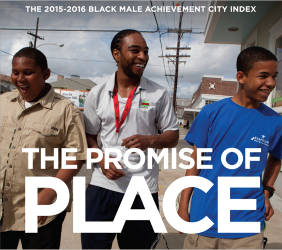By Ariele Vaccaro
 In a new report ranking 50 American cities’ by their commitment to and progress toward bettering the lives of Black men, Milwaukee came in at 16.
In a new report ranking 50 American cities’ by their commitment to and progress toward bettering the lives of Black men, Milwaukee came in at 16.
The Campaign for Black Male Achievement (CBMA) released the Black Male Achievement City Index on Thursday.
It’s part of a report called “Promise of Place: Cities Advancing Black Male Achievement”. The report grades each city on a scale from one to 100. At the top of the list were Detroit and Oakland, Calif., both with a score of 95.
Dead last was Columbus, Ga. with a score of 15.
CBMA rated the cities based on a number of factors, including the cities’ level of commitment to Black men and boys, its membership in the CBMA national network, the existence of national initiatives — like My Brother’s Keeper — on a local level, and the amount of philanthropic funding used for growing organizations that aim to increase opportunity for Black men and boys.
According to Board Chair of CBMA Tonya Allen, the report is meant to encourage cities to do more for Black men.
“We want these conversations to be spread across the country, and that all city leaders are talking about it,” Allen said during a Wednesday conference call.
The 50 cities represented in the report are home to 30 percent of the country’s African-American population.
The report highlighted the top-scoring cities, pointing out public and private initiatives that have been making strides toward bettering conditions for Black males. Among some of the initiatives were newly founded offices of African-American affairs.
Though Milwaukee was not included on the list of top-performers, it is among those that have recently opened up those offices.
The report comes not long after the County Board’s November unanimous approval of a new Milwaukee County Office of African-American Affairs.
On Wednesday, CBMA held a conference call featuring representatives from some of the 50 cities included in the report. Louisville, Ky. took 21st. Anthony Smith is CEO at Cities United and Former Director for Safe and Healthy Neighborhoods in Louisville.
He noted that, in order for cities to begin improving the quality of life for Black men, they have to prioritize incarcerated Black men and offer assistance and opportunity to those being released from prison.
“We’ve got to be ready to take them back in as a community,” said Smith.
Also in on the conference call was Chris Chatmon of African-American Male Achievement and Oakland Unified School District (OUSD).
According to Shawn Dove, CEO at CBMA, Oakland has seen recent increases in high school graduation rates and decreases in suspension of Black students.
It was among those cities noted for its Office of African-American Male Achievement, part of OUSD.
Detroit, sharing the top of the list, was listed as having the highest percentage of Black men and boys making up the male population, 81 percent.
It was the highest ratio of Black males in the list of top-scoring cities, with about $15 million between 2008 and 2012 in targeted funding to support Black men and boys.
The city that allocated the most funding was New York City with more than $36 million between 2008 and 2012.
However, the city’s Black male population was far less than that of Detroit, with 24 percent of men being African-American.
Before ending the conference call, Allen emphasized the importance of political and philanthropic leadership that makes Black male achievement a priority by “[making] a political statement about this issue, not just funding it.”
The report can be found at cityindex.blackmaleachievement.org.



